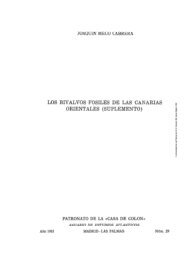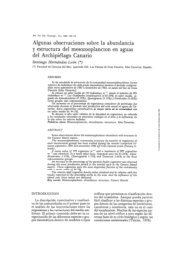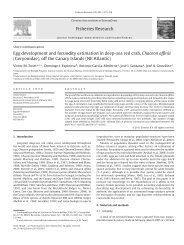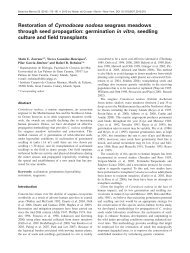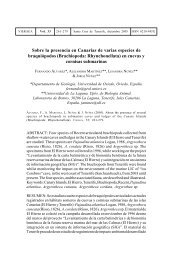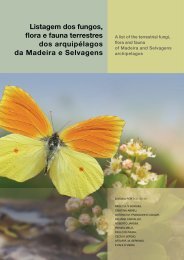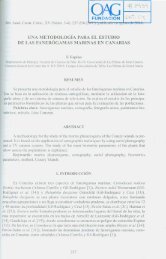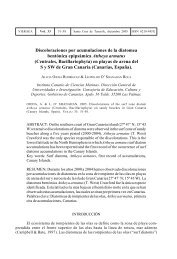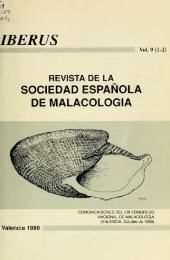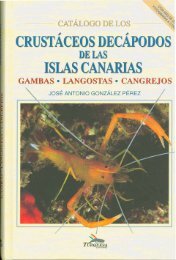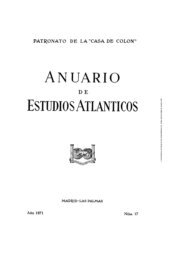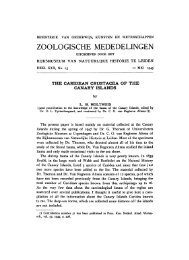A REVIEW OF GERARDIIDAE (ANTHOZOA: ZOANTHARIA ... - redmic
A REVIEW OF GERARDIIDAE (ANTHOZOA: ZOANTHARIA ... - redmic
A REVIEW OF GERARDIIDAE (ANTHOZOA: ZOANTHARIA ... - redmic
Create successful ePaper yourself
Turn your PDF publications into a flip-book with our unique Google optimized e-Paper software.
Organ IOrigin I<br />
Nematocyst<br />
type<br />
Mean and range (in parentheses)<br />
of length and with of IN<br />
nematocyst capsules in /l<br />
Ecology<br />
A Homolrichs (I)? 9,2 (7,8-10) x 1,7 (1,4-2) 3<br />
B Homotrichs (I)? 9,6 (7,8-12,2) x 1,8 (1,1-2,8) 17<br />
e Homolrichs (s) 12,3 (11-13) x 3,3 (2,5-4) 4<br />
o Homotrichs (s) 15 x 2,8 1<br />
o Homolrichs (I)? 8,3 (8-9) x 2 3<br />
E Homolrichs (s) 13,4 (12-15) x 2,3 (2-2,5) 6<br />
E Homolrichs (I)? 8,7 (8-10) x 2,1 (1,8-2,5) 6<br />
Gerardia macaronesica is a typical species from circalittoral and deep infrali<br />
bottoms that often occur on Antipathella wollastoni, forming a very interesting associatil<br />
This association is very characteristic around the Macaronesian islands, except in<br />
Verde, where the zoanthids occur mostly on the antipatharian Tanacetipathes cavernicola.<br />
has been collected from 12 (only in some special habitats) to 100 meters deep, althoughv,<br />
little is known about its abundance in deeper bottoms. G. macaronesica is able to show<br />
eral ecological adaptation forms, but on infralitora! bottoms always is placed in dark<br />
tats, as vertical walls, cave gates, ruffs and big crevices, and in other habitats with the Ii;<br />
conditions diminished. Big colonies with their own skeleton have been noticed at some<br />
cial environments, where they find the ecological conditions to do it (this on!y has<br />
observed in scarce sites at Canary Islands). These environments seem to be exposed pl<br />
with high water movement. This is a key factor in order to understand the ecological di<br />
bution of this species. We find the most important concentration of G. macaronesica<br />
ing on its own skeleton in flat rocky and moderate sandy bottoms (Fig. 8a), but also in VI<br />
tical walls at the exposed islets (Fig. 8b), both habitats with high water movements. '<br />
morphology of the colonies and branches orientation can be quite different from one col,<br />
to another, being more related to water movements than any other factor. In the ex<br />
islets in Canary Islands (Montaña Clara, norte de Lanzarote) G. macaronesica was obse.<br />
together with the gorgonian Paramuricea grayii and a species of the genus Eunicel/a suD<br />
be identified. In deep infralitoral and circalitora! bottoms, and with different environ ,<br />
conditions, the zoanthid can also form rather neglected or not very conspicuou~ pOPula:..<br />
growing on walls and crevices (also exclusively noticed at Canary Islands), wlth very<br />
skeleton development (OCAÑA et al., 1995) [25], like fine axis hardly noticed froro<br />
wall (Fig. 9b). In this habitat the polyp's density is lower than in the other, but the zoan<br />
can cover a big piece of the substrate (Fig. 9a). . tatI<br />
The species grow on antipatarian on many occasions; some parts of the anl1P~~<br />
coenenchyme are damaged and destroyed by the zoanthid. It seems to be a case o it .<br />
sltlsm, . . where the zoant h'd I IS . growmg . on th e antlpatanan .. coenenc hy, me covenng . skc<br />
including alive parts inside the colenteron. The final result is to get the antipat~nanofSUI<br />
ton as an axis where grow up. Still, have to be studied if there is some absorptJOnlauSi<br />
stances that may bring some trophy benefits to the zoanthid, but it should be a ~nes"<br />
option to take it in account. Having demonstrated the serious damages that G.maca<br />
.. lharians, we think that the inquilinism (see MORTON, 1989) [21] can<br />
lhe:anllp



